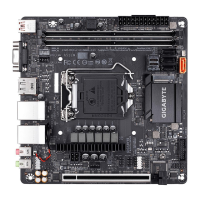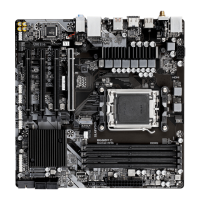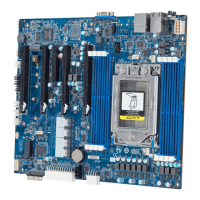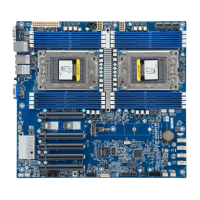Chapter3 Appendix
Beforeyoubegin,pleasepreparethefollowingitems:
• At least two SATA hard drives or SSDs.
(Note 1)
(To ensure optimal performance, it is recommended that you
use two hard drives with identical model and capacity).
(Note 2)
• Windows setup disk.
• Motherboard driver disk.
• A USB thumb drive.
ConguringtheOnboardSATAController
A.InstallingSATAharddrive(s)inyourcomputer
Install the hard drives/SSDs in the Intel
®
Chipset controlled connectors on the motherboard. Then connect the
power connectors from your power supply to the hard drives.
B.ConguringSATAcontrollermodeinBIOSSetup
MakesuretoconguretheSATAcontrollermodecorrectlyinsystemBIOSSetup.
Steps:
1. Turn on your computer and press <Delete> to enter BIOS Setup during the POST (Power-On Self-Test).
Go to Peripherals\SATAAndRSTConguration, make sure SATAController(s) is enabled. To create
RAID,setSATAModeSelection to IntelRSTPremiumWithIntelOptaneSystemAcceleration. Then
save the settings and restart your computer. Note: When using a PCIe SSD, make sure to set the UseRST
LegacyOROM item under Peripherals\SATAAndRSTConguration to Disabled. Then depending the M.2
connector you use, set the corresponding PCIeStorageDevonPortXX item to RSTControlled. Finally,
save the settings and exit BIOS Setup.
2. TocongureUEFIRAID,followthestepsin"C-2."ToenterthelegacyRAIDROM,referto"C-3"formore
information. Finally, save the settings and exit BIOS Setup.
3-1 ConguringaRAIDSet
The BIOS Setup menus described in this section may differ from the exact settings for your motherboard.
The actual BIOS Setup menu options you will see shall depend on the motherboard you have and
the BIOS version.
(Note1) AnM.2PCIeSSDcannotbeusedtosetupaRAIDseteitherwithanM.2SATASSDoraSATAharddrive.
(Note2) Referto"1-8InternalConnectors,"fortheinstallationnoticesfortheM.2andSATAconnectors.
RAIDLevels
RAID0 RAID1 RAID5 RAID10
Minimum
Number of Hard
Drives
≥2 2 ≥3 4
Array Capacity Number of hard
drives*Sizeofthe
smallest drive
Sizeofthesmallest
drive
(Number of hard
drives-1)*Sizeof
the smallest drive
(Number of hard
drives/2)*Sizeofthe
smallest drive
Fault Tolerance No Yes Yes Yes
C-1.UEFIRAIDConguration
Steps:
1. In BIOS Setup, go to BIOS and set CSM Support to Disabled. Save the changes and exit BIOS Setup.
2. After the system reboot, enter BIOS Setup again. Then enter the Peripherals\Intel(R)RSTeSATAController
sub-menu.
3. On the Intel(R)RSTeSATAController menu, press <Enter> on CreateRAIDVolume to enter the Create
RAIDVolume screen. Enter a volume name with 1~16 letters (letters cannot be special characters) under
the Nameitemandpress<Enter>.Then,selectaRAIDlevel.RAIDlevelssupportedincludeRAID0,RAID
1,RAID10,andRAID5(theselectionsavailabledependonthenumberoftheharddrivesbeinginstalled).
Next, use the down arrow key to move to Select Disks.
- 44 -

